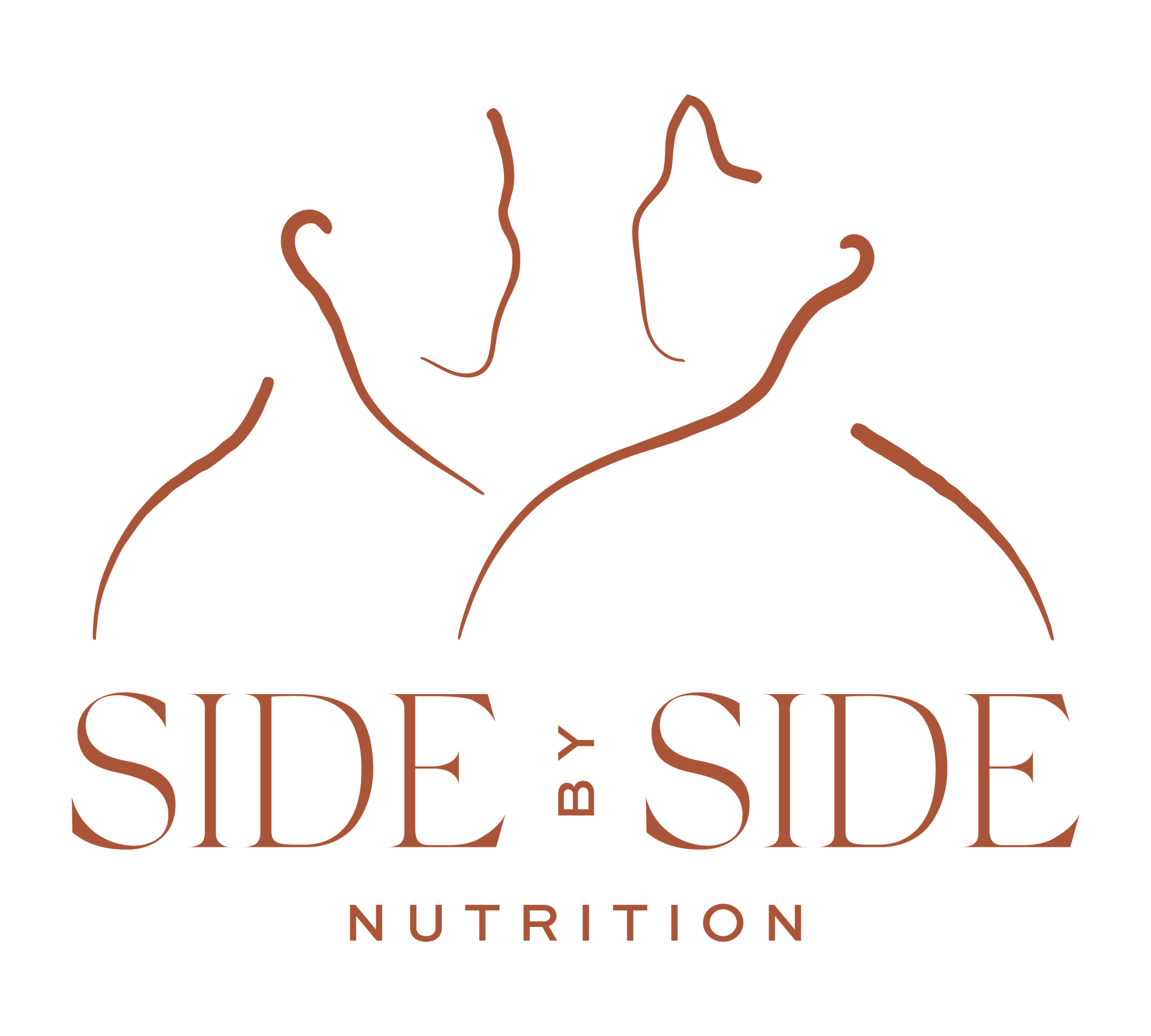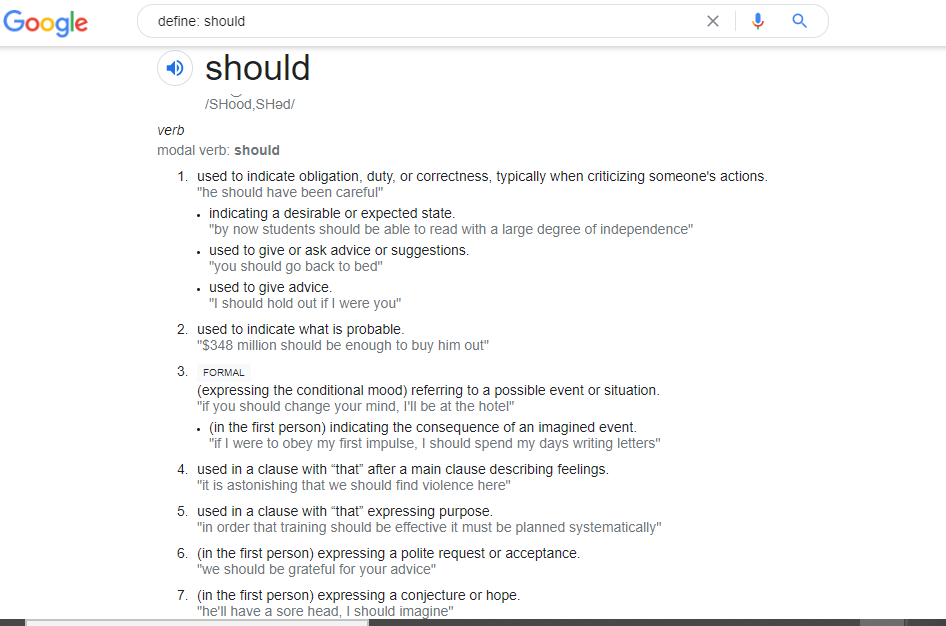How to Quit Shoulding All Over Yourself
No matter how far along we get, we tend to be the kind of animals who glance over our shoulder, just to be sure. This instinct can be helpful and protect us from that last lurking danger we barely caught from the corner of our eye.
But we’re also the kind of animals who like to stay with the group, so once we confirm we’re safe (for now), we tend to focus ahead and run with the pack. Because getting blindsided is dangerous and being abandoned is dangerous, we learn to keep our heads on a swivel, alternating between getting ahead and reaching behind in a way that makes safety feel like a very small bubble.
This is how I think about the concept of Should.
I did the cheesy writing thing and went to look up the ~official~ dictionary definition of “should” for a transition here. Did you know there are at least 8 defined uses??
When my clients use the word “should,” it typically goes like this:
“Well, I figured I shouldn’t eat that because it’s the same snack I give to my kids.”
“Yeah my knees are hurting, but we’re always told we should exercise every day.”
“How do we know how much we should be eating if we only rely on hunger?
“I know I shouldn’t feel this way. It’s not that big of a deal.”
“I should be better.”
How would you describe Should? I’ve experienced it as expectant, inflexible, and monumental. You may describe it as standard, painful, a moving target. I believe the instinctive feelings that drive Should in us stem from our brain and body’s inherited wisdom from centuries of the chase scenario I described up top. Those perpetual double checks keep us confirming the bubble is safe to move forward, but the problem with Should is what we lose when meticulously applying that same method to our body choices today: movement. Shoulds keep us stuck! We artificially create a predator behind us, for example-- weight change, and we don’t want to lose our community running with us, so we do everything we can to maintain the perfect pace. But, as we all have learned, perfection is an impossible expectation, and mimicking perfection is unsustainable. (Ya ever seen a bodybuilder lift a truck? It can be done, but not for very long.)
Shoulds & expectations drown out your true wants & desires, discounting them as less important and taunting you to doubt your intuition, fostering distrust.
Think about it: Should starts a self-sustaining spiral. It implies a question, but never results in a helpful answer.
If you ask why repeatedly with any Should, you’ll likely end up where you started, at another should, or at “I don’t know.” No wonder we’re all exhausted when we try to live by Should! Any sense of security is provided by the appearance of guardrails which, when grasped are actually a mirage.
~~~
“I should eat these sugar-free candy substitutes to curb my cravings for the real thing”
1. Why? 'Because then I won’t eat as much'
2. Why don’t you want to eat as much as you’d like? 'Because they have sugar'
3. Why are you concerned about sugar? 'Because it’s bad for you'
4. Why do you think is sugar bad? 'Because it’s unhealthy and we want to eat a lot of it'
5. Why do you think that is? 'Because it...well don’t they say we shouldn’t eat sugar?'
aaand here we are right back at another Should.
Shoulds and sugar-frees are a lot alike that way: empty, unsatisfying, and still leaving you wanting.
This is your permission to give that Should back.
Ever considered where your “Shoulds” come from? If they’re not authentic to your wants, why are they there?
So how do we break out of this well-cemented thought pattern? My answer is to replace your Shoulds with Hows + Whats. Shoulds tell us something is wrong but offer no evidence and no path to resolution. How+What instead invites us to think critically.
Hows provide a quick, relatively objective assessment of the situation.
Whats help us discover our actual, internal wants and desires.
How to Quit Should for Good
Step 1) Catch your Should statement or thought as you notice it
Step 2) How are things really? How is it right now? How am I feeling or doing?
Step 3) What do I truly want? What would I imagine ideally? What do I envision? What is possible? What do I want to be different? What would I prefer?
That’s all you need to know to start slaying your Shoulds!
Half the time, you may realize you are already at your true what, and that stops Should in its tracks. But sometimes, we discover a ‘what’ that we want to work towards.
Curious about how we get from your How to your What?
Together, How + What builds a bridge, and we can absolutely move forward on a bridge.
Sometimes, this is a short, simple bridge. But we still build that in brick by brick whether the solution is challenging or if it seems simple. Our “bricks,” may vary but we generally use strategies, plans, coping skills, patience, self-compassion.
Example. I shouldn’t be hungry after getting seconds
How: This is how often I am still hungry after meals.
What: I want to feel satisfied and comfortably full.
Bridge: Eat more at meals
Bricks: I will increase my portion sizes by 50% at my first serving, and make sure to have at least my typical amount at second serving. I’ll observe how I am feeling and decide whether to get more food. If this is helpful, we’ll keep at it, if not, my dietitian can help me check my portion sizes and variety next session.
When we remove the Should, we remove the shame that makes judgements on our needs and causes us to question our reliable internal cues.
(Want more practice rewriting your shoulds? Check out the bonus examples below)
You, my friend, deserve more than Should. Shoulds are a ticket to a destination you did not choose. You are capable to decide where you want to go, where your vision of success lives. Hey, without Should, you may notice often you are already there! Exactly where you want to be, need to be, or can be.
As we are strengthening our internal resilience, honoring body cues, and amplifying the recovery voice, try to remember that “should” has never done anybody any good.
Help clear your path forward by shoveling all that Should out of your way.
Practice Templates
About the Author
"Kymber Stephenson is a Registered Dietitian Nutritionist living and working in the Greater Denver area. Her experience began with a love of food which led her to pursue a degree in Culinary Arts from Johnson & Wales University. As her love of science and helping people wove with that initial path, she continued on to a Bachelor of Science in Culinary Nutrition with a dual concentration in clinical dietetics and culinary food science.
Kymber is especially passionate about eating disorder management and prevention. In this vein, she focuses on educating clients about the multi-faceted ways history, marketing, food systems, culture, psychology, and body image affect health and relationships to nutrition, food, and body. She works with clients to truly fall in love with food again, acknowledging not only its nourishing properties, but truly embracing its comforts, tradition, and fun! Working in a client-guided manner with a Health at Every Size approach, she strives to help each unique person reach their idea of peace and satisfaction in their bodies and their overall lives. Kymber's driving philosophy is that all people deserve equitable access to quality food and evidence-based nutrition education, regardless of status or background."










